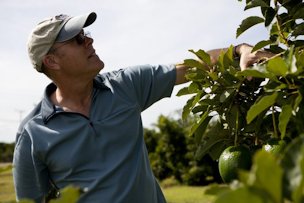Article from
VSCNews, Vegetable and Specialty Crop News
by Abbey Taylor, editor
An Avocado Tree’s Worst Nightmare

Jonathan Crane, professor of horticultural sciences,
inspects an avocado tree at the Tropical Research
and Education Center.
Laurel
wilt could be considered an avocado tree’s worst enemy. According to
Jonathan Crane, professor of horticulture and tropical fruit specialist
with the University of Florida, laurel wilt was introduced in the
United States in 2002 and made its way to Homestead, Florida, in 2012.
Since then, over 100,000 avocado trees have been lost, equaling roughly
1,000 acres of production.
Laurel wilt is a fungal disease that
quickly spreads from tree to tree. If it is not caught early, it can
destroy multiple trees in a matter of days. The disease is spread in
two ways: ambrosia beetles and grafting of roots from one tree to
another.
Ambrosia beetles use the fungus as a food source. “They
have a symbiotic relationship with it, so they grow that fungus inside
the tree,” Crane explains.
The beetles bore into the trees and
inoculate it with the fungus. Then, the beetles lay eggs and eat the
fungus as it sporulates. At this point, the tree begins to wall off the
beetles and the fungus. However, the fungus continues to sporulate and
travel throughout the tree until it enters the water-conductive tissue.
“The tree ends up dying from drought stress because it has walled off
so much of its water-conductive tissue,” Crane says.
It can be anywhere between two to eight weeks from the time a tree is infected to the time it dies.
Another
way the disease can travel is through root grafts. According to Crane,
laurel wilt travels between the root grafts of adjacent trees. If
infected trees are not identified and treated in a timely manner, the
disease will spread at a rapid rate.
The first signs of laurel
wilt can be seen in the leaves. “By the time you see the green leaves
wilting, it’s already wreaked a bit of havoc inside the tree,” Crane
explains. He says the telltale sign of disease movement is if the green
leaves have turned brown. Then, it is important to pay close attention
to the adjacent trees for signs of laurel wilt.
Crane says right
now there are no basic methods for controlling laurel wilt, but
scouting is a good first step. Growers will want to look for wilting
trees. “If you find them (wilted trees), you immediately take the trees
out of the ground and disconnect the root system from its neighbors.
Then, you destroy the wood so the beetles can’t make more beetles,”
Crane explains. However, he adds, removing trees from the property is
labor intensive and expensive.
The other management method is to
infuse the tree with a fungicide, so the tree never gets infected in
the first place. Crane says Florida growers have about 1,000 to 1,200
trees being injected with fungicides, and the trees have to be injected
multiple times.
Since both methods of management are costly and
require a strong labor force, Crane and his team are working on finding
new methods for management, including finding alternative fungicides.
Currently laurel wilt is in 10 states, from North Carolina to Florida, and is found on the east coast of Texas.
|
|
